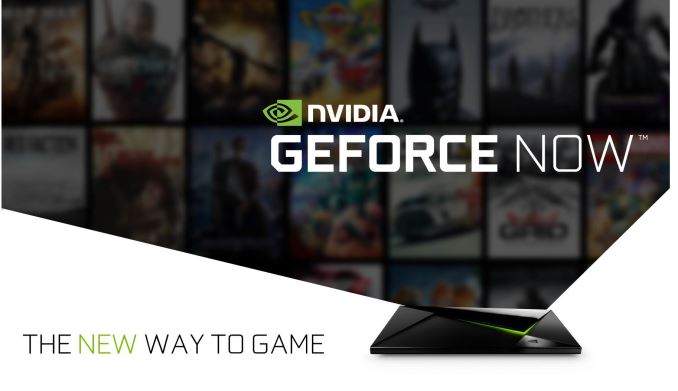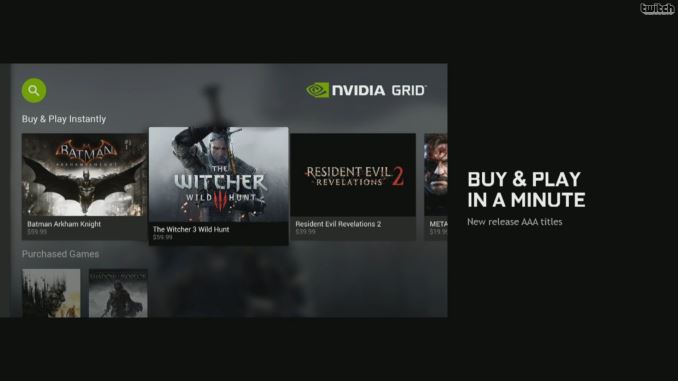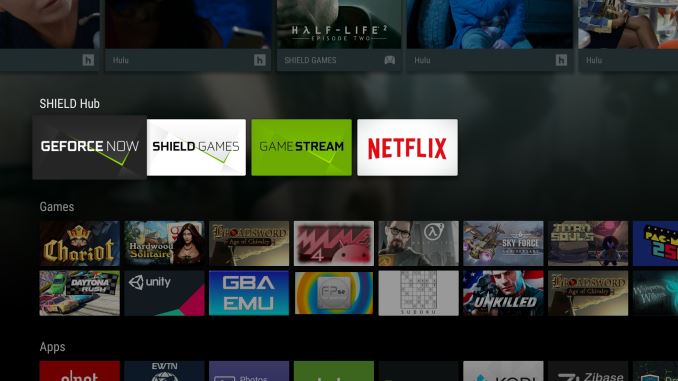NVIDIA's GeForce NOW - GRID Cloud Gaming Service Goes the Subscription Way
by Ganesh T S on September 30, 2015 9:00 AM EST- Posted in
- NVIDIA
- Shield
- Android TV
- Cloud Gaming

NVIDIA's GRID game streaming service was launched back in 2013 as a beta project. Over the last couple of years, they have added a number of features that bring together the capabilities of their data center GPUs and their Tegra SoCs. At GDC 2015, NVIDIA indicated that they would be promoting the GRID program from beta to a commercial service. The commercial service was originally slated to launch along with the SHIELD Android TV in May, but the launch kept getting pushed back.
Today, NVIDIA is announcing that the service is getting out of beta with a new tag - GeForce NOW. With widespread and reliable Internet connectivity, content consumption is going the streaming way - services such as Netflix, Spotify and Hulu boast a huge subscriber base. NVIDIA is hoping that GeForce NOW will become the de-facto service for consumers looking to stream games.
Game streaming is quite challenging compared to traditional media streaming - in addition to low latency real-time encoding on the server side, we also need the client user input to have minimal lag while getting reflected on the server side. Companies such as OnLive and Gaikai have tried to address this market with mixed success (getting bought out by Sony in 2015 and 2012 respectively).
However, from our limited time over the past two years with the GRID beta service, we have to say that the experience can be quite compelling - the gaming experience is instant without having to wait for multi-gigabyte downloads, and one has a huge library of games to choose from (similar to Netflix's library of movies). NVIDIA has been pushing hard to keep latency within reason - generally aiming for the equivalent of a console game at 30fps - and while network quality and location are paramount here, reasonably low latency is attainable if you live close enough to one of NVIDIA's hosting facilities.
Moving on, NVIDIA believes that the other major advantage for their streaming service is that the rendering GPUs are in the data center and can be regularly upgraded. The end-user side just needs a dumb decoder and gaming controller - the SHIELD Android TV is quite future proof here, as it can easily decode 4Kp60 streams and has a GbE LAN connector - so only the hosting side would need to catch up. Currently, the GeForce NOW experience provides for game streaming at up to 1080p60 at 25 Mbps, while a 720p30 stream at less than 10 Mbps is also available for users with limited bandwidth. Similar to Netflix, NVIDIA uses adaptive bit-rate streaming that can scale the quality appropriately within the available bandwidth.
The initial focus of GeForce NOW is on the SHIELD Tablet and SHIELD Android TV. NVIDIA also has long-term plans to enable PCs as clients for the service.
As for the structure of the service, back in March NVIDIA announced that this would be a multi-tier basic/premium service. However as things have been finalized, NVIDIA has reduced that to a single tier of paid service, and there has been no talk of a basic or free service ala the current free beta. As such the GeForce NOW service will be priced at $8/month, with a 3-month free trial period starting after sign-up.
In terms of games, the catalog has been fairly consistent in the type of games NVIDIA is offering over the lifetime of the GRID beta, and it appears that this will continue to be the case for the paid service. This would mean that the games on the subscription service will largely be second-run games that have already been on the market for 6 months or more; the previous Batman game, the next-to-latest GRID game, etc, with 50 or so games to kick things off. In this sense GeForce NOW is very similar to the early days of Netflix, with the service acting as a way of accessing second-run content for cheap.

GeForce NOW Buy & Play (From NVIDIA's March Service Announcement)
However NVIDIA is still bringing brand-new games to the service as well, and as previously announced back in March this will be through their Buy & Play program. Under Buy & Play, newer games that aren't available from the publisher for full subscription licensing can instead be purchased by individual customers for use with the streaming service, allowing customers to buy and immediately play these games on GeForce NOW. NVIDIA tells us that they will be rolling out new games under this program on a weekly basis, with the service launching with heavy hitters such as The Witcher III and Resident Evil: Revelations 2 available via Buy & Play on day one. However we should also note that based on NVIDIA's comments, it sounds like you must remain a subscriber in order to access the GeForce NOW service at all, so individual games picked up via Buy & Play would not be available if you discontinued your subscription.
Wrapping things up, NVIDIA has told us that GeForce NOW will be available in the US, Canada, Europe (incl. western Russia), Japan and South Korea starting today. The launch regions have been mainly dictated by the availability of data centers to serve the regions with minimal latency.
Finally, as part of the updates today, NVIDIA will also be more widely selling the SHIELD Android TV. In particular, Europe (UK, Germany, France and the Nordics) will finally be receiving the console, bringing the console beyond the American shores. Meanwhile in the US, we will start to see the STB available in brick and mortar stores such as Best Buy, Frys and Micro Center. And last but not least in a marketing promotion, Google Fiber outlets will also be promoting the SHIELD Android TV.











44 Comments
View All Comments
ruthan - Wednesday, September 30, 2015 - link
Shield is progressing, but progress seems too slow. No new AAA game announced and price tag is problem, 100$ for 450 GB of space and 200$ for 16 GB model in comparison with Sony and MS consoles is too much.Im looking forward to new PS Vita like Shield with mobile modem, this could be realy big hit, isnt Shield TV inst.
inighthawki - Wednesday, September 30, 2015 - link
I recall Sony just recently making a statement that they are not going to do a PS Vita successor do to the lack of a market. I wouldn't get my hopes up.vision33r - Thursday, October 1, 2015 - link
Vita is dead because Sony can only afford to do mobile and Playstation. Vita is money loser. Who buys a new Vita every year? There are much more people who buys a new mobile phone every year.Aftershocker - Friday, October 2, 2015 - link
I think the 16GB model is as reasonable ask but the $100 mark up for a 500GB Hybrid drive is unacceptable. If it was a $50 markup it would be a no brainerddriver - Wednesday, September 30, 2015 - link
Because people love latency and how it enriches the gaming experience.ddriver - Wednesday, September 30, 2015 - link
Also, I bet people will appreciate when lousy streamed gaming takes up the bandwidth for the content that will not be ruined by the extra latency.Seriously, can't people really tell what is practical and makes sense from lame fads?
dgingeri - Wednesday, September 30, 2015 - link
SaaS and IaaS are still big things. Obviously, many people can't tell what is practical and makes sense. When we start having companies go bankrupt because an internet connection got cut by a construction crew, then they'll see how bad that idea is.Cloud services are good for hosting web sites for customer access and offsite backup storage, but not for providing things that should be internal. With Iaas and SaaS, if the internet connection goes down, then the users can't do anything, and productivity goes to absolute zero. If a company has their infrastructure internally, they can keep working, even if they can't do all they need. The company can keep limping along. IaaS and SaaS is placing the very existence of the company in the hand of others, and that is just not practical.
ddriver - Wednesday, September 30, 2015 - link
Not to mention the security risk. Hack a server and get access to a treasure trove, it will be much less fruitful to hack a single user system. And as the last few years have shown, corporate IT security is laughably bad. People think it is good but it really isn't. And especially in cloud services, where there are too many holes to plug and make for a secure environment.nyqxyl - Wednesday, September 30, 2015 - link
We've all had stuff in the cloud for a long time now.. web-based email, videos on Youtube, photos on .. so on and on, you know the drill. So.. why is it that games suddenly make you think there's a high security risk?Speaking of bandwidth used, it's just a video stream. It's no different than spectating a game on Twitch, for instance, at a similar resolution and quality. Why is it that for some reason, this would consume more bandwidth?
Latency is a different issue, granted.. but I presume this kind of service is more for casual gamers.. those who want to just quickly surf through a large library, without needing to own every single game (With AAA titles, it can add up very quickly, you know.. in comparison, $8/month is peanuts.) For those who are interested in investing hundreds of hours building any elaborate or competitive skill in a single game, they're better off with a PC (which isn't disappearing anywhere, of course.. )
ddriver - Wednesday, September 30, 2015 - link
While gaming on its own doesn't seem to be that much of a privacy risk, cloud gaming will obligatory require user information, some of it potentially critical, such as credit card number, since you no longer simply purchase the game and play it, but use it as a service which will be continuously charged.So could gaming provides worse experience through the higher latency while also increasing the security risk associated with gaming from non-existent to serious.